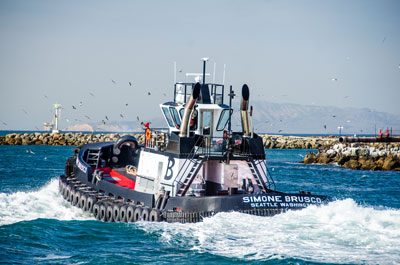In the drive to build ASD tugs of late, Brusco Tug & Barge has quietly continued a measured expansion of its ship-docking fleet, working in the quieter West Coast ports.
Brusco, based in Longview, Wash., has its tugs at Everett, Olympia and Grays Harbor, in Washington, and at Port Hueneme, Sacramento, Stockton and Eureka, in California.
In October 2013, Brusco took delivery of the 78-foot Simone Brusco, and assigned it to Port Hueneme, in Ventura County, north of Los Angeles. Simone Brusco is the third in a series of tugs designed by Robert Allan Ltd. and built at Diversified Marine in Portland, Ore.
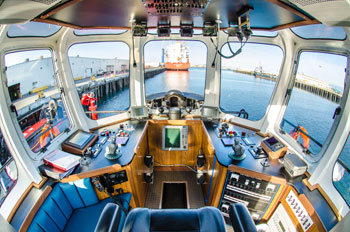 |
|
At the helm Mike Fullilove, Brusco’s general manager in Port Hueneme, Calif. |
The first tug, Wynema Spirit, built in 2001, is at Grays Harbor. The second tug, Lulapin, built in 2005, is also at Port Hueneme, where the pair are employed docking car carriers and fruit ships. They also assist at the U.S. Naval Base Ventura County. A fourth tug in the series, Peter J. Brix, was delivered from Diversified to Brusco’s Grays Harbor fleet in March, and a fifth boat, yet to be named, is scheduled to be delivered later in the year.
Simone Brusco and her sisters are an evolution of Vancouver naval architect Robert Allan’s Cates class ASD tugs, dedicated to C.H. Cates and Sons (now Seaspan) of North Vancouver, British Columbia. Cates was one of the first long-term clients of Robert Allan Ltd. Simplicity and cost-effective construction are features of the class, with tugs that are able to quickly maneuver and respond in tight spots.
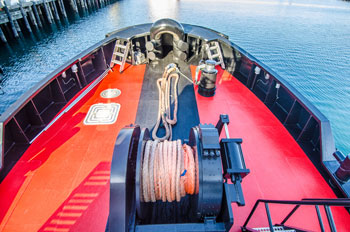 |
|
The Markey 50-hp electric hawser winch with Saturn 12 line. |
“We haven’t got a lot of space in this port,” said Capt. Mike Fullilove, general manager of Brusco’s Port Hueneme operation, “so we built these boats, in size and horsepower, for this port. When you have a containership at Berth 1 and a car carrier at Berth 2, and we have to bring a ship in between them, we only have 200 or 250 feet to maneuver. We also have a 1,000-foot turning basin, but when you bring in those 230-meter ships, you don’t have a lot of room.”
There are some real differences between the first two boats and Simone Brusco. One is an upgrade to Tier 3 Caterpillar 3512C, 2,000-hp main engines turning Rolls-Royce Aquamaster 205 z-drives. At 4,000 hp, as opposed to 3,600 in the older boats, the engines produce enough power to produce 55 tons of bollard pull. “They’re virtually the same boat with more horsepower,” said Fullilove. “The extra horsepower and bigger drives make a big difference.”
“I’m really impressed with the quality of the boats that Diversified turns out,” said Willy Brown, Brusco’s port engineer at Port Hueneme. “The engine room is well lit, with lots of space, and the plumbing is real simple. All the systems are basic and simple. And having the fire pump run off of one of the generators assures that we won’t be hindering one of the mains in the case we might have to maneuver while pumping water.”
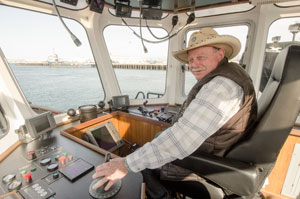 |
|
The pilothouse of the compact and nimble tug. |
The second notable change is the angle of the bow staple. The staple on the first boat, Wynema Spirit, was originally perpendicular to the deck. The Port Hueneme crew, often called upon to assist ships with steeply flared hulls, fabricated a replacement staple for Wynema that is racked back 37°. The new staple was integrated into the design of Simone Brusco, Peter J. Brix and the fifth boat.
“When the tugs pushed on the stern counter, they dive down a bit, and the staple would come close to the ship’s hull,” said Fullilove. The angle staple allows the tugs to work more ships on the counter. Fullilove said they also noticed that with the angled staple, the tug’s stern set deeper in the water when it was in the wake of a ship while pulling hard on the stern to slow the vessel down. “That reduced the cavitation and vibration. And when the tug is pulling hard, the line tends to lift the stern a bit. By angling the staple back, we cut a lot of that out. We also put two horns on each side of the staple in case we have to make off the lines.”
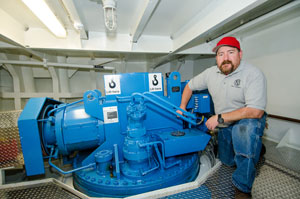 |
|
Brusco Port Engineer Willy Brown with one of the Rolls-Royce Aquamaster 205 z-drives that produce a bollard pull of 55 tons. |
One application of the horns is during an assist of a ship with Panama chocks. “We put the line up around the chock and bring it back down and make the eye of the line off on one of the horns,” said Brown.
Directly behind the bow staple, Simone is fitted with a Markey DEPC-48 50-hp, single-drum, electric render/recover hawser winch. The workhorse winch is wound with 400 feet of 2 5/8-inch Saturn 12 synthetic rope, and features high braking capacity and fast line speeds for escort and ship-assist work. The controls are situated in the wheelhouse, but there are on-deck emergency stop and freewheel pushbuttons.
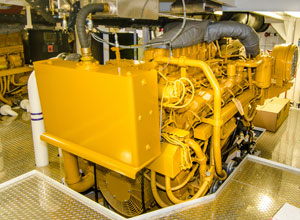 |
|
The two Tier 3 Caterpillar 3512C engines generate a total of 4,000 hp. |
Surrounding the deck machinery on the bow, and extending around the perimeter of the hull, are several courses of heavy duty SR3D-2 double-loop fendering supplied by Schuyler Rubber of Woodinville, Wash.
“In addition, Schuyler provided SR3D-2 fenders for the upper and lower bow along with a course of Shibata cylindrical rubber on the upper leading bow edge,” said Schuyler’s co-owner, Greg Armfield. “This fender will help in limiting chafing on the lines.”
The continuous cylindrical fendering system was developed to cushion the wider bow radius on modern ship-assist tugs and to distribute the load generated by their higher horsepower. The result is that most modern harbor tugs do not need rubber tire fenders. However, the Brusco boats also function as the Port Hueneme pilot boats.
“The pilots are a very important part of what we do,” said Fullilove. Therefore, in addition to the cylindrical fendering, Simone has a row of rubber tire fendering along each side of the hull that provides extra cushioning when transferring the pilots on and off the ships in the open ocean.
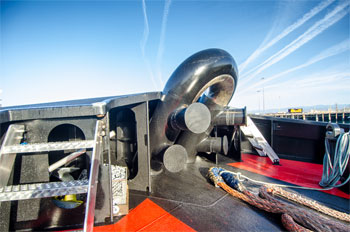 |
|
The bow staple is angled back to allow the tug to get in close to ships. |
The crew at Port Hueneme also designed and fabricated a man-overboard cable and swing davit system for retrieving pilots if they end up going overboard. “We’ve never had to use it, but we drill with the pilots often,” said Fullilove. “And they have to jump in the water here in the turning basin and out past the sea buoy.”
The Brusco fleet at Port Hueneme has a diverse portfolio of work in addition to assisting ships in and out of the harbor. “We are not officially a fireboat, but we are an integral component in the port, in that aspect,” said Fullilove.
The firefighting system on Simone Brusco consists of a 1,000-gpm Darley fire pump, driven by one of the John Deere auxiliary generators, and piped to a Chemguard monitor on the forward wheelhouse deck.
The piping from the engine room runs up the exterior of the superstructure to the monitor, and has a valve to redirect the flow to shoreside firefighting equipment.
“We’re very proud of working with the Ventura County Fire Department,” said Fullilove. “We do fire drills with them, and we’re the only vessels in the harbor equipped to supply them with water to fight fires.”
In March, the modules for the fifth Cates-class tug of the growing Brusco fleet were lined up in Diversified Marine’s yard overlooking the Columbia River. Simone Brusco and her sisters are spry, tough and compact vessels. Their design elements will likely be emulated in other ports.

